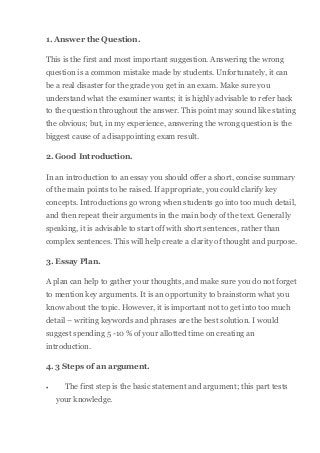7 tips for essay writing
•
2 gostaram•208 visualizações
Read more about writing tips on my blog. Leave your comment you need any help. http://generate-my-essay.blogspot.com
Denunciar
Compartilhar
Denunciar
Compartilhar
Baixar para ler offline

Recomendados
Recomendados
Mehran University Newsletter is a Quarterly Publication from Public Relations OfficeMehran University Newsletter Vol-X, Issue-I, 2024

Mehran University Newsletter Vol-X, Issue-I, 2024Mehran University of Engineering & Technology, Jamshoro
https://app.box.com/s/7hlvjxjalkrik7fb082xx3jk7xd7liz3TỔNG ÔN TẬP THI VÀO LỚP 10 MÔN TIẾNG ANH NĂM HỌC 2023 - 2024 CÓ ĐÁP ÁN (NGỮ Â...

TỔNG ÔN TẬP THI VÀO LỚP 10 MÔN TIẾNG ANH NĂM HỌC 2023 - 2024 CÓ ĐÁP ÁN (NGỮ Â...Nguyen Thanh Tu Collection
Mais conteúdo relacionado
Destaque
Destaque (6)
Último
Mehran University Newsletter is a Quarterly Publication from Public Relations OfficeMehran University Newsletter Vol-X, Issue-I, 2024

Mehran University Newsletter Vol-X, Issue-I, 2024Mehran University of Engineering & Technology, Jamshoro
https://app.box.com/s/7hlvjxjalkrik7fb082xx3jk7xd7liz3TỔNG ÔN TẬP THI VÀO LỚP 10 MÔN TIẾNG ANH NĂM HỌC 2023 - 2024 CÓ ĐÁP ÁN (NGỮ Â...

TỔNG ÔN TẬP THI VÀO LỚP 10 MÔN TIẾNG ANH NĂM HỌC 2023 - 2024 CÓ ĐÁP ÁN (NGỮ Â...Nguyen Thanh Tu Collection
Último (20)
This PowerPoint helps students to consider the concept of infinity.

This PowerPoint helps students to consider the concept of infinity.
Unit-IV; Professional Sales Representative (PSR).pptx

Unit-IV; Professional Sales Representative (PSR).pptx
TỔNG ÔN TẬP THI VÀO LỚP 10 MÔN TIẾNG ANH NĂM HỌC 2023 - 2024 CÓ ĐÁP ÁN (NGỮ Â...

TỔNG ÔN TẬP THI VÀO LỚP 10 MÔN TIẾNG ANH NĂM HỌC 2023 - 2024 CÓ ĐÁP ÁN (NGỮ Â...
Basic Civil Engineering first year Notes- Chapter 4 Building.pptx

Basic Civil Engineering first year Notes- Chapter 4 Building.pptx
Food Chain and Food Web (Ecosystem) EVS, B. Pharmacy 1st Year, Sem-II

Food Chain and Food Web (Ecosystem) EVS, B. Pharmacy 1st Year, Sem-II
Unit-V; Pricing (Pharma Marketing Management).pptx

Unit-V; Pricing (Pharma Marketing Management).pptx
Z Score,T Score, Percential Rank and Box Plot Graph

Z Score,T Score, Percential Rank and Box Plot Graph
ICT Role in 21st Century Education & its Challenges.pptx

ICT Role in 21st Century Education & its Challenges.pptx
7 tips for essay writing
- 1. 1. Answer the Question. This is the first and most important suggestion. Answering the wrong question is a common mistake made by students. Unfortunately, it can be a real disaster for the grade you get in an exam. Make sure you understand what the examiner wants; it is highly advisable to refer back to the question throughout the answer. This point may sound like stating the obvious; but, in my experience, answering the wrong question is the biggest cause of a disappointing exam result. 2. Good Introduction. In an introduction to an essay you should offer a short, concise summary of the main points to be raised. If appropriate, you could clarify key concepts. Introductions go wrong when students go into too much detail, and then repeat their arguments in the main body of the text. Generally speaking, it is advisable to start off with short sentences, rather than complex sentences. This will help create a clarity of thought and purpose. 3. Essay Plan. A plan can help to gather your thoughts, and make sure you do not forget to mention key arguments. It is an opportunity to brainstorm what you know about the topic. However, it is important not to get into too much detail – writing keywords and phrases are the best solution. I would suggest spending 5 -10 % of your allotted time on creating an introduction. 4. 3 Steps of an argument. The first step is the basic statement and argument; this part tests your knowledge.
- 2. The second step is to explain your statement. Don’t forget you need to explain in relation to the question. Also, just because you think the explanation is obvious, doesn’t mean you can avoid putting it down. The third step is to look at the argument with critical distance. This is an opportunity to discuss why the basic premise may be wrong or limited. It is an opportunity to show you can think for yourself, rather than just memorise a list of points. This final step, called analysis or evaluation, is the most difficult part, but is required to get the highest mark. I write this with Economics in mind, but, I’m sure it is relevant to others subjects as well. 5. Conclusion. In a conclusion you can weigh up the different arguments and decide which are the strongest and most relevant. A conclusion should try to add something new, and not just repeat previous points. For example, you can say why an argument is particularly strong and give justification. 6. How Much To Write? I often get asked this question by students. So many students will write 1 side and then stop, almost in mid sentence, because they think this means they have finished. There is no right answer as to how much you should write. The important thing is to write as much as you can in the allotted time, but, only write what is relevant. Although it is true quality is more important than quantity, don’t try to do a minimalist style and write as little as possible. Generally speaking, if you write more you have a better chance of getting more points across. 7. Did you answer the Question?
- 3. Hopefully you didn’t leave it to the end of your answer to realise you answered the wrong question.